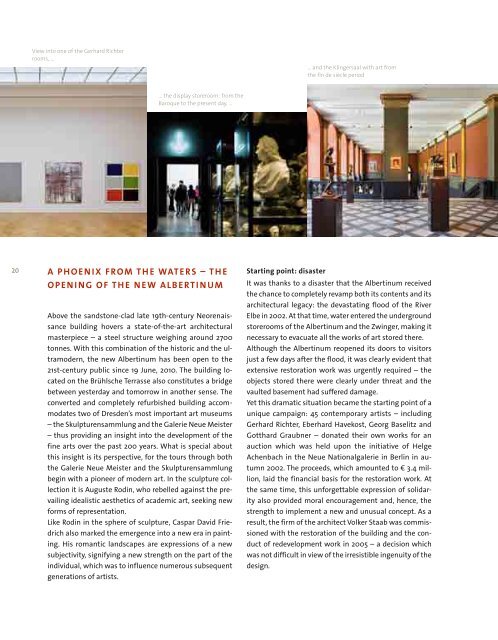Annual Report 2010 - Staatliche Kunstsammlungen Dresden
Annual Report 2010 - Staatliche Kunstsammlungen Dresden
Annual Report 2010 - Staatliche Kunstsammlungen Dresden
Create successful ePaper yourself
Turn your PDF publications into a flip-book with our unique Google optimized e-Paper software.
View into one of the Gerhard richter<br />
rooms, …<br />
… the display storeroom: from the<br />
Baroque to the present day, …<br />
20 A pHoen IX FRoM tH e WAteRS – tH e<br />
open I nG oF tH e n eW AlBeRtI n uM<br />
Above the sandstoneclad late 19thcentury Neorenaissance<br />
building hovers a stateoftheart architectural<br />
masterpiece – a steel structure weighing around 2700<br />
tonnes. With this combination of the historic and the ultramodern,<br />
the new Albertinum has been open to the<br />
21stcentury public since 19 June, <strong>2010</strong>. The building located<br />
on the Brühlsche Terrasse also constitutes a bridge<br />
between yesterday and tomorrow in another sense. The<br />
converted and completely refurbished building accommodates<br />
two of <strong>Dresden</strong>’s most important art museums<br />
– the Skulpturensammlung and the Galerie Neue Meister<br />
– thus providing an insight into the development of the<br />
fine arts over the past 200 years. What is special about<br />
this insight is its perspective, for the tours through both<br />
the Galerie Neue Meister and the Skulpturensammlung<br />
begin with a pioneer of modern art. In the sculpture collection<br />
it is Auguste Rodin, who rebelled against the prevailing<br />
idealistic aesthetics of academic art, seeking new<br />
forms of representation.<br />
Like Rodin in the sphere of sculpture, Caspar David Friedrich<br />
also marked the emergence into a new era in painting.<br />
His romantic landscapes are expressions of a new<br />
subjectivity, signifying a new strength on the part of the<br />
individual, which was to influence numerous subsequent<br />
generations of artists.<br />
… and the Klingersaal with art from<br />
the fin de siècle period<br />
Starting point: disaster<br />
It was thanks to a disaster that the Albertinum received<br />
the chance to completely revamp both its contents and its<br />
architectural legacy: the devastating flood of the River<br />
Elbe in 2002. At that time, water entered the underground<br />
storerooms of the Albertinum and the Zwinger, making it<br />
necessary to evacuate all the works of art stored there.<br />
Although the Albertinum reopened its doors to visitors<br />
just a few days after the flood, it was clearly evident that<br />
extensive restoration work was urgently required – the<br />
objects stored there were clearly under threat and the<br />
vaulted basement had suffered damage.<br />
Yet this dramatic situation became the starting point of a<br />
unique campaign: 45 contemporary artists – including<br />
Gerhard Richter, Eberhard Havekost, Georg Baselitz and<br />
Gotthard Graubner – donated their own works for an<br />
auction which was held upon the initiative of Helge<br />
Achenbach in the Neue Nationalgalerie in Berlin in autumn<br />
2002. The proceeds, which amounted to € 3.4 million,<br />
laid the financial basis for the restoration work. At<br />
the same time, this unforgettable expression of solidarity<br />
also provided moral encouragement and, hence, the<br />
strength to implement a new and unusual concept. As a<br />
result, the firm of the architect Volker Staab was commissioned<br />
with the restoration of the building and the conduct<br />
of redevelopment work in 2005 – a decision which<br />
was not difficult in view of the irresistible ingenuity of the<br />
design.

















